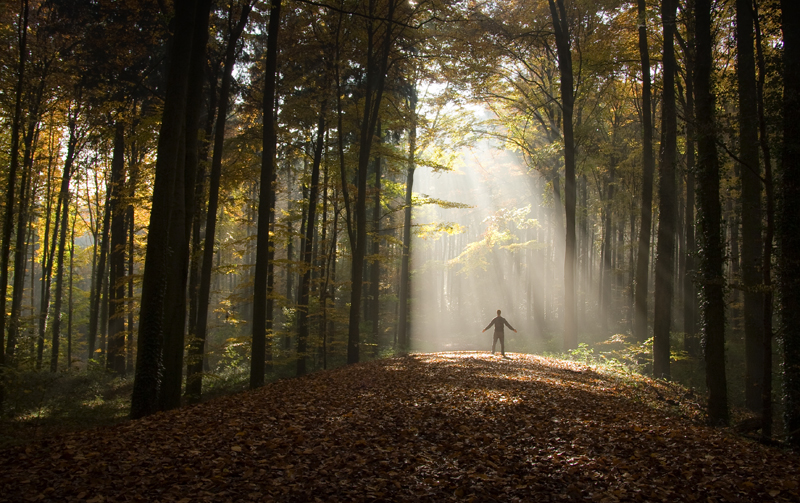Ability to see the cultural value of wilderness boils down, in the last analysis, to a question of intellectual humility.
Author and conservationist Aldo Leopold wrote these words in 1949, and they are all the more important today.
As we enter the 21st century and today’s children look forward to living in the 22nd, this lack of intellectual humility is harming us in a number of ways.
Most notably, humanity is fundamentally and unintentionally changing the shape of the natural world. But the scientists who best understand this shift typically use only the language of science and reason – data and models – to explain it.
This overreliance on science and reason makes it difficult to communicate with the general public. It also blinds us to the full scope of the issues we now face, which can be fully grasped only through the emotional, cultural, ethical and spiritual perspectives on the world.
Leaving room for the mysterious and unexplainable
Geophysicists have proposed that we have entered the Anthropocene, a new geologic epoch defined by humanity’s influence on the planet and nature’s systems. What we do to adapt to this new reality requires that we augment our scientific ways of studying the natural environment with the wisdom to appreciate our intellectual limitations.
For example, scientific reason relies on data and analysis, and yet there is much in this world that cannot be measured; one cannot provide data that proves that love for another human being, a spiritual connection with the natural world, a sense of calling of vocation or the presence of God all exist. And yet, a great many people believe – or even know – that these exist.
Scientific reason also seeks to understand the natural world by breaking it down into individual parts. But it is the integrity of the whole that matters, what Rachel Carson called the “web of life.”
Finally, scientific reason seeks to explain all phenomena through words and numbers. And yet there are many experiences that defy articulation; classical pianists or professional athletes often have great difficulty verbalizing the essence of their experience when they are perfecting their craft.
So, while science can continue to advance in exploring the rational in nature, by analyzing natural systems through “big data” models using feedback loops, time delays, accumulations and nonlinearities that operate within them, it must also leave room for the mysterious and unexplainable, exercising a humility that it does not and may never know its full complexities.
Just as we cannot state with certainty that cigarettes will cause any one individual to get cancer given the complexities of the human body, so too are we limited in our ability to predict the impact of our actions on the natural environment. The 1964 surgeon general’s report actually states that “statistical methods cannot establish proof of a causal relationship in an association [between cigarette smoking and lung cancer]. The causal significance of an association is a matter of judgment which goes beyond any statement of statistical probability.“ The protection of the natural world must also be a matter of judgment, based on both faith and reason.
Beyond the Enlightenment understanding
As we enter the Anthropocene Era, we are faced with a transformative cultural shift that calls us to move beyond the Enlightenment thinking of the 17th and 18th centuries, a period that was built on a shift from perceiving nature as subsuming the human endeavor and being animated by mystical forces, to one in which humankind treated nature as a machine that can be disassembled and analyzed through reason and the “conquest of nature.”
Instead, we need to recognize that the scientific method that was essential to the Enlightenment is no longer fully adequate to understand the natural world and our impact upon it.
More specifically, we need to recognize that a scientifically derived understanding as our only understanding of the environment leads to a utilitarian and mechanistic awareness of the natural world. That framing leads to many of the pathologies we now face: behaviors that lead to climate change, water scarcity and species extinction on a massive scale - and hampers our ability to appreciate – and therefore protect – nature for reasons that go beyond the limits of our understanding.
In the Anthropocene, we have become, in the words of Stephen Jay Gould, “the stewards of life’s continuity on Earth. We did not ask for this role, but we cannot abjure it. We may not be suited to it, but here we are.” To play this role properly requires a deeper reverence and respect for what we do not know or understand.
Honoring the mystical in nature
Consider some of the unpredictable ways that nature is revealing itself.
For example, since the reintroduction of wolves in Yellowstone National Park in 1995, biologists have observed changes in the entire ecosystem in ways they never imagined. Among other surprises, who would have thought that wolves could change the course of rivers? Yet scientists have found that the presence of wolves prevents elk and deer from overgrazing riverside plants, which in turn stabilizes riverbanks and slows erosion.
Rachel Carson elevated discussion of the natural world beyond scientific understanding toward appreciation and wonder in its complexity and mystery. U.S. Department of Agriculture, CC BY
Scientists studying red foxes within the park in winter, meanwhile, have noted that the foxes catch more mice – sometimes pouncing from as far as 20 feet away and through three feet of snow – when they are facing north. This has led some to hypothesize that the foxes triangulate off the magnetic field of the Earth when pursuing their prey. Not so outrageous: scientists have long been studying Magnetoreception, suspecting that birds' eyes contain molecules that sense Earth’s magnetic field. These examples, and many more, remind us that, for every advance in our understanding of nature, we can only marvel that there is ever more that we do not know.
Rachel Carson eloquently captured this idea when she wrote:
Contemplating the teeming life of the shore, we have an uneasy sense of the communication of some universal truth that lies just beyond our grasp. What is the message signaled by the hordes of diatoms, flashing their microscopic lights in the night sea? What truth is expressed by the legions of barnacles, whitening the rocks with their habitations, each small creature finding the necessities of its existence in the sweep of the surf? And what is the meaning of so tiny a being as the transparent wisp of protoplasm that is a sea lace, existing for some reason inscrutable to us — a reason that demands its presence by a trillion amid the rocks and weeds of the shore? The meaning haunts and ever eludes us, and in its very pursuit, we approach the ultimate mystery of Life itself.
By capitalizing the word Life, Carson is calling forth something that demands our respect, evoking motivations like sacred, divine, reverence and love. This is what Pope Francis is doing with his Encyclical Letter Laudato Si. When viewed through these lenses, utilitarian arguments for protecting the environment – for example, making the “business case” to address climate change – sound absurd.
But scientific reason has limited capacity for considerations beyond the rational and utilitarian, and this diminishes science’s influence by distancing its conclusions from the general public. To many, scientists are seen as a class of people who “privilege the rational over the intuitive or spiritual, separate fact from values and emotions, and act contrary to religious beliefs about the ‘natural’ order of things,” as historian Richard Hofstadter wrote in his 1964 Pulitzer Prize-winning book.
Psychologist Jonathan Haidt adds that scientists are “devoted to documenting only to what is, rather than what is good or what is beautiful,” thereby elevating reason over faith. Warns Michael Crow, president of Arizona State University, “We are increasingly filled with hubris, filled with arrogance, cut off from the general public, and unable to find an appropriate tone with which to communicate.”
To fully appreciate the complexities of nature and reach more people in explaining them, academics and scientists must approach study of the natural world with the strength of data and models, a humility of their limitations, an awareness of the unintended consequences they so often create and a recognition of the emotional, cultural, ethical and spiritual perspectives on the world. In short, it requires scientists to not only be smart, but also be wise.
The above is based on Andy’s new book, “Finding Purpose - Environmental Stewardship as a Personal Calling,” published by Greenleaf Publishing.
 Andrew J. Hoffman, Holcim (US) Professor at the Ross School of Business and Education Director at the Graham Sustainability Institute, University of Michigan
Andrew J. Hoffman, Holcim (US) Professor at the Ross School of Business and Education Director at the Graham Sustainability Institute, University of Michigan
This article was originally published on The Conversation. Read the original article.




 How America courted increasingly destructive wildfires − and what that means for protecting homes today
How America courted increasingly destructive wildfires − and what that means for protecting homes today  GesiaPlatform Launches Carbon-Neutral Lifestyle App ‘Net Zero Heroes’
GesiaPlatform Launches Carbon-Neutral Lifestyle App ‘Net Zero Heroes’  Evercore Reaffirms Alphabet’s Search Dominance as AI Competition Intensifies
Evercore Reaffirms Alphabet’s Search Dominance as AI Competition Intensifies  How is Antarctica melting, exactly? Crucial details are beginning to come into focus
How is Antarctica melting, exactly? Crucial details are beginning to come into focus  As the Black Summer megafires neared, people rallied to save wildlife and domestic animals. But it came at a real cost
As the Black Summer megafires neared, people rallied to save wildlife and domestic animals. But it came at a real cost  Parasites are ecological dark matter – and they need protecting
Parasites are ecological dark matter – and they need protecting  Airline Loyalty Programs Face New Uncertainty as Visa–Mastercard Fee Settlement Evolves
Airline Loyalty Programs Face New Uncertainty as Visa–Mastercard Fee Settlement Evolves  Rise of the Zombie Bugs takes readers on a jaw-dropping tour of the parasite world
Rise of the Zombie Bugs takes readers on a jaw-dropping tour of the parasite world  Swimming in the sweet spot: how marine animals save energy on long journeys
Swimming in the sweet spot: how marine animals save energy on long journeys  Bitcoin Reserves Hit 5-Year Low as $2.15B Exits Exchanges – Bulls Quietly Loading the Spring Below $100K
Bitcoin Reserves Hit 5-Year Low as $2.15B Exits Exchanges – Bulls Quietly Loading the Spring Below $100K  Lake beds are rich environmental records — studying them reveals much about a place’s history
Lake beds are rich environmental records — studying them reveals much about a place’s history 


































